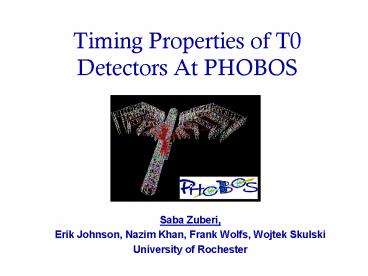Timing Properties of T0 Detectors At PHOBOS - PowerPoint PPT Presentation
1 / 15
Title:
Timing Properties of T0 Detectors At PHOBOS
Description:
Collisions of Au-Au, d-Au and ... Hadrons, such as K, p, p, produced in collision are detected. ... Ten detectors in a ring on either side of collision point. ... – PowerPoint PPT presentation
Number of Views:19
Avg rating:3.0/5.0
Title: Timing Properties of T0 Detectors At PHOBOS
1
Timing Properties of T0 Detectors At PHOBOS
- Saba Zuberi,
- Erik Johnson, Nazim Khan, Frank Wolfs, Wojtek
Skulski - University of Rochester
2
OUTLINE
- Brief introduction to PHOBOS
- Particle ID and why the timing properties of T0s
are important? - Time of Flight (TOF) Detector
- Dependence of timing resolution on voltage and
position of incident particles - Results
- Summary
3
RHIC Little Big Bang on Long Island
- Two rings 2.4 miles long.
- Collisions of Au-Au, d-Au and p-p studied.
- Ions have energies of up to 100GeV/nucleon for Au
and 250GeV/nucleon for p. - Bunches of billions of particles travel with
speeds up to 0.99995c. - Matter formed in head on collisions reaches
temperatures of 1012 oC in region of diameter
10-14m.
4
RHIC Physics Goals
- At everyday energies the basic building blocks
of matter, quarks and gluons are confined in
hadronic matter. - At RHIC energies, quarks and gluons become
deconfined and the formation of Quark Gluon
Plasma (QGP) is potentially possible. QGP is
believed to have existed microseconds after the
Big Bang. - New phase of matter is expected to last for
10-23sec. - Hadrons, such as K, p, p, produced in collision
are detected. - Properties of expected phase transition of matter
inferred from particles produced. - PHOBOS Physics Aim To investigate properties of
hadron - production at extreme energy densities.
5
PHOBOS Detector
6
Particle ID and Time Of Flight
- Low momentum particles (eg.pplt55MeV/c,
pKlt135MeV/c) - Stopped in Spectrometer arms.
- Identified from dE/dx and ETOT.
- Higher momentum particles
- Enter magnetic field and momentum measured.
- Identified from dE/dx and p
- (eg. p/K separation 0.6GeV/c)
- High momentum particles
- Reach the TOF walls.
- Momentum and TOF allows mass of particle to be
calculated.
7
Extension of Particle ID to High Momentum Region
TOF detector extends particle ID to higher
momentum region.
- Timing Resolution, sTOF, of TOF must be smaller
than the difference in the time-of-flight in
order to distinguish between particles of
different mass with same momentum. - Timing resolution of TOF, sTOF, limits momentum
range of particle identification. - Require timing resolution of TOF, sTOF100ps.
With TOF p/K separation 0.6GeV/c to 1.2GeV,
K/p separation 1.2Gev/c to 2GeV
(L1.7m,sTOF100ps)
8
Determining Time-of-Flight
- T0 counters determine time of collision
- TOF Wall determines time of arrival.
- Accuracy of arrival time and collision time
measurements determine sTOF.
9
TOF Walls
T0 Detectors
- Cerenkov radiators, 50mm in diameter, coupled to
fast PMTs. - Cerenkov radiation is produced when charged
particles in a medium have a velocity faster than
the speed of light in that medium. - Ten detectors in a ring on either side of
collision point. - Can determine the collision point to within 50mm.
- Each TOF wall consists of 120 scintillation slats
0.8x0.8x20cm3, coupled to two PMTs (top and
bottom). - Position of incident particles is determined and
allows spectrometer tracks to be matched with TOF
hits.
T0 Counters installed at RHIC
TOF Wall installed at RHIC
10
Photomultiplier Tubes
- PMT
- Photoelectron is emitted when cathode is struck
by photon. - Dynode chain accelerates and amplifies current as
secondary electrons are emitted - Final signal collected from anode.
- PMT Time Resolution depends on
- Variation in transit time of electrons through
tube - Fluctuations due to statistical noise.
- Gain is the amplification factor of the PMT.
- Gain depends on number of dynodes in chain and a
secondary emission factor. GK?V?n
http//laxmi.nuc.ucla.edu8248/M248_99/autorad/Sci
nt/pmt.html
T0 detector
11
Dependence of T0 Timing Resolution on Supply
Voltage
Dependence of T0 Timing Resolution on Position of
Incident Particles
- For larger supply voltage, T0 detectors have
larger gain and provide larger signals. - Expect timing resolution, sTO to improve with
increased voltage. - To avoid saturation of PMTs operate at as low a
voltage as possible without sacrificing sTO. - Determine dependence of T0 timing resolution, sTO
on supply voltage and optimum operating voltage.
- Possible non-uniformity due to
- Cerenkov radiator
- Optical grease coupling the radiator to the PMT
- Geometry of T0 detector
- This may lead to variation in sTO depending on
position of incidence.
12
Experimental Setup
- Timing properties were studied using cosmic rays.
- Two 0.8x0.8x0.8cm3 plastic scintillating
detectors used to confine position of incidence
and provide start time in timing measurements. - Supply voltage of the start detectors is kept
constant and T0 voltage is varied.
- Position scan conducted in two ways
- Diameter Scan
- Circumference Scan
- The vertical distance between the detectors
remained constant.
13
Result Timing Resolution vs. Supply Voltage
- Timing resolution improves with increased voltage
up to -2700V. - At -2700V achieved a 55ps resolution.
- The testing system has an intrinsic resolution of
50ps.
14
Result Timing Resolution vs. Position of
Incident particles
- No significant variation in T0 timing resolution
was observed either across the diameter of the
detector, or around its circumference.
Circumference Scan
Diameter Scan
15
Summary
- The timing resolution of the TOF subsystem limits
the particle id capabilities in high momentum
region. - The T0 timing resolution is found to have little
dependence on the position of incident particles. - Verified that the most effective operating
voltage for the T0s is -2700V, where sT0 55ps. - Beyond 2700V the supply voltage does not
influence the timing resolution of the T0
counters.































